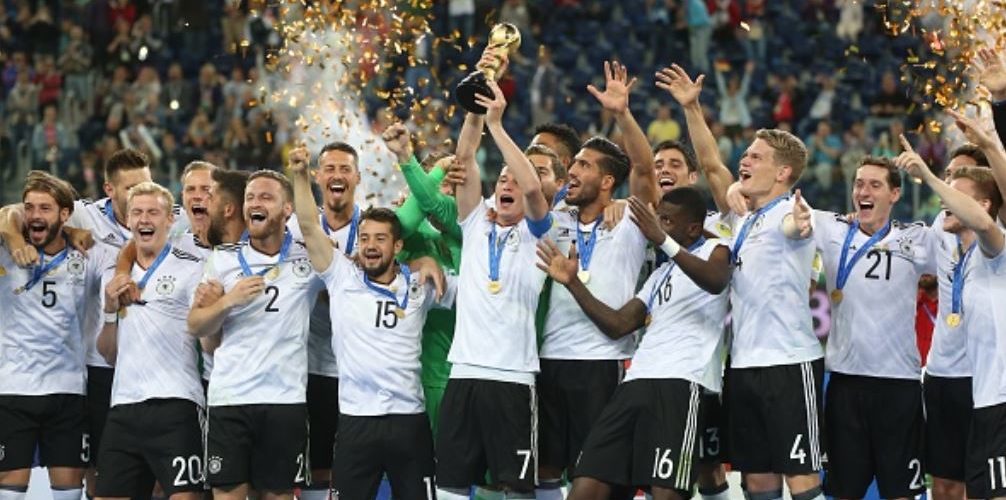Image: Getty/Anadolin Agency
At the turn of the millennium, German football was in a state of decline. Although traditional giants Bayern Munich won the Champions League in 2001, Die Mannschaft’s best days appeared behind them as the national team slumped to an embarrassing group stage exit at Euro 2000. A 5-1 defeat on home soil the following year to rivals England epitomised their struggles in the early noughties.
Despite reaching the World Cup final ten months later, the football on display appeared outdated in the modern era with the physicality and tenacity often associated with German football nowhere to be seen as another group stage exit at Euro 2004 saw the round ball superpower scratching their heads in search of a resolution to their woes.
By then, work had already commenced on a radical restructuring of youth development across the country with a renewed focus on developing infrastructure and pathways for juniors to forge professional careers.
40-year-old German coach Lutz Schubbert played his part in this revolution and acts a coach at his regional youth performance centre in the north-west of Germany. Additionally, the UEFA A licensed coach works as an opposition analyst for his third tier German side VFL Osnabruck, which last season was battling for promotion to the second tier.
A professional coach for 17 years now, Schubbert visited Melbourne in December last year as part of the TF14 Talent Identification Program where he ran coaching clinics in conjunction with a handful of other European coaches and scouts. He offered his thoughts on Australian football while providing an insight into how Germany transformed its youth structure to become World Champions?
Q: Tell us the position that German football found itself during the late 90s/early 2000s and what was the root cause of the problem?
We thought that we were unbeatable after winning the 1990 World Cup but after that began a decline and many of us were shocked by the results of our national team. We always had good players but they weren’t developed well and the world turns around while you’re stuck.
We stopped and realised that we had totally forgotten our youth as most Bundesliga clubs didn’t give much attention to their academies and only focused on the professional team. That status during those days was to neglect grassroots junior football and only begin to look at it once the best kids turned 15-16 to see which players were capable of playing in the first team.
Q: Nowadays Germany is recognised as the home to some of the best young talent in world football. What was done to turn things around?
After that some clever people came together in a taskforce and questioned some things about German football. They determined that a net needed to be built where every talent across the country would be seen. The next step after finding the best players was to give them the best development which is based on two points.
The first was that the federation was to have a system until the ages of 14-15 whereby every talent would be developed at their grassroots football club but also with extra training. The second point was the building of youth performance centres across the country and in each of the respective regions. Thus, we wanted to build a great net of talent before ensuring every talented player would have extra training.
Then we built youth performance centres while ensuring each team had professional youth structures and this is what they now have. There was a lot of resistance in the beginning by many of the big clubs and most of them now recognise this as a successful business model to develop players, bring them to the first team before selling them or increasing the potential of the first team.
At the moment, German football is on cloud nine due to the various triumphs of its respective national teams lately. Are there any deficiencies or limitations to the current model?
Right now, our system works so perfectly but we only get the same type of players out of it. We are not flexible and don’t have the courage to increase personalities and that is right now the biggest challenge for us. The fact that we have built a black box where we only produce a certain type of player.
You see that with the luck of true centre-forwards in German football which can be attributed to the youth performance centres and talent identification programs at youth level. There was a time when we did not believe in these types of players and looked for players who were 180 centimetres, had small shoulders and were technically gifted. But modern number nines are 190, very strong, slower but score.
In our search for another type of player, we ignored the traditional number nine. Additionally, we also have a lack of traditional wingers in our game and that is reflective at Bayern Munich whose wingers for the last decade have been Ribery and Robben. German football has struggled to produce such players.
Having spent a week in Melbourne observing the local scene, what are your impressions of Australian football, its players and whether there is anything we can take out of the German approach?
It is always difficult to work within professional football due to the competitiveness of it. My opinion of Australian players is that they are a mixture of the British physically and the Americans mentality wise. This is a very good combination and an attractive prospect for many clubs in Germany where many American and Australian players have succeeded in the past.
From what I see with Australian players, they have the willingness and physical strength to compete at a high level. I have a lot of respect for Australia so I don’t want to be too critical. I can only say what works well in Germany and that is organisation which provides a huge boost to our economy, society and football infrastructure.
My advice to my Australian counterparts is to take care of your talented players and provide them with a clear path towards professionalism and from what I observed I could not find that clear path as there are many different avenues a player could take. Having said that, the German way does not work for everyone and what works well back home won’t necessarily work well in Australia. Moreover, the message is to never get complacent and always question everything, even when you are doing well.
***
The 2017 edition of the Talent Identification Program is just over a week away. Coaches, scouts and team personnel from 10 different clubs will fly to Melbourne and conduct five days of training sessions in the hopes of scouting prospective Australia talent. Representatives from Croatian powerhouse Dinamo Zagreb, Dutch sides Heerenveen and Twente, Serie A side Atalanta, MLS franchise Chicago Fire, Danish second tier side Esjberg, in addition to Bulgarian and Macedonia heavyweights Levski Sofia and Vardar Skopje will be in attendance at the trials held at Jack Edwards Reserve in Oakleigh.
2016 saw a handful of youngsters earn trials in Europe with Heerenveen and Dinamo Zagreb respectively while a number of players were offered senior contracts. In addition to the foreign contingent present, representatives from Melbourne City and Victory are expected to be in attendance as well as numerous NPL coaches.
The program is open to any players over the age of 13 (2004-born and older) with the trials running from 14-15 and 18-20 December. For more information about the program, including costs, contact TF14 director Boris Ivanov on 0413 470 575 or via email on Boris@tf14.net. The eight respective particants of the program include:
Boban Babunski – First-Team Assistant Coach at Vardar Skopje
Andjelko Ivanjko – Head of Youth at Dinamo Zagreb
John Lammers – Head Coach of Esbjerg
Flavio Margotto – Technical Manager and Youth Team Affiliation Manager at Atalanta
Nelson Rodriguez – General Manager of Chicago Fire
Marin Slavchev – Technical Scout of Levski Sofia
Niek Westra – Youth Coach at Heerenveen
Kenneth Zandvliet – Head of Academy Scouting at FC Twente

